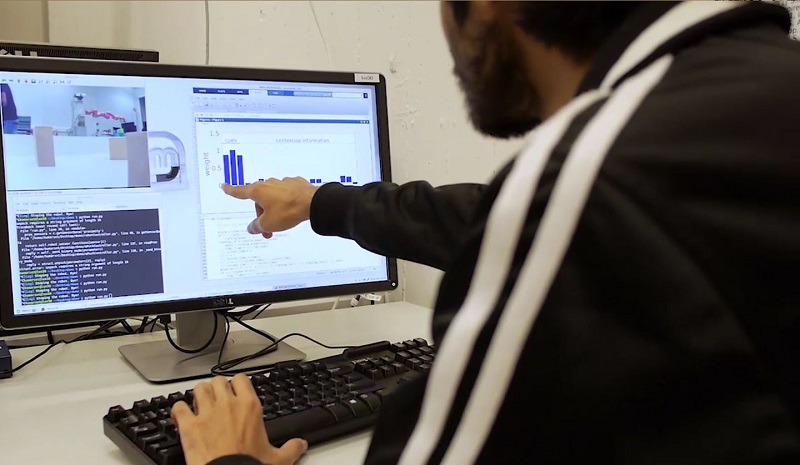
F01 – Focus Group Learning Dynamics
Sen Cheng, Onur Güntürkün, Metin Üngör
The trial-by-trial dynamics of behavioral changes can reveal the mechanisms underlying learning. Most experiments, however, quantify learning by comparing a post- to a pre-learning block and thus are blind to the dynamics during learning. Other studies obtain learning curves by averaging across subjects, but if learning systematically differs between individuals, the average learning curve can be misleading. As a service to other projects, this Focus Group will export support and training in the application of trial-by-trial and intra-trial analysis methods to these groups. Furthermore, the Focus Group will import data from the projects for the pursuit of a cross-cutting scientific agenda: to compare the learning dynamics across different individuals, learning stages, experimental paradigms, and species.
Guiding questions of F01:
- Does the learning dynamics differ fundamentally between different learning paradigms or species? Or just in their parameters?
- Are the dynamics of extinction learning and that of acquisition governed by different mechanisms?
- Which factors, such as cues and contextual information, drive changes at a trial-by-trial resolution, and beyond, in individual subjects?
- How do the dynamics of behavioral changes relate to that of neural activity and psychophysiological variables?

10 project-relevant publications
Batsikadze G*, Diekmann N*, Ernst TM, Klein M, Maderwald S, Deuschl C, Merz CJ, Cheng S, Quick HH, Timmann D (2022) The cerebellum contributes to context-effects during fear extinction learning: a 7T fMRI study. NeuroImage:119080. https://doi.org/10.1016/j.neuroimage.2022.119080
Donoso JR, Packheiser J, Pusch R, Lederer Z, Walther T, Uengoer M, Lachnit H, Güntürkün O, Cheng S (2021) Emergence of complex dynamics of choice due to repeated exposures to extinction learning. Anim Cogn 24:1279–1297. https://doi.org/10.1007/s10071-021-01521-4
Nio E, Pereira PP, Diekmann N, Petrenko M, Doubliez A, Ernst TM, Batsikadze G, Maderwald S, Deuschl C, Üngör M, Cheng S, Merz CJ, Quick HH, Timmann D (2025) Human cerebellum and ventral tegmental area interact during extinction of learned fear. eLife 14:RP105399. https://doi.org/10.7554/eLife.105399
Packheiser J, Donoso JR, Cheng S, Güntürkün O, Pusch R (2021) Trial-by-trial dynamics of reward prediction error-associated signals during extinction learning and renewal. Prog Neurobiol 197:101901. https://doi.org/10.1016/j.pneurobio.2020.101901
Petrenko M, Coenen L, Doubliez A, Ernst TM, Nio E, Diekmann N, Uengoer M, Cheng S, Merz CJ, Timmann D, Batsikadze G (2025) Appetitive and aversive classical conditioning: Self-reports and physiological responses. Behav Brain Res 484:115509. https://doi.org/10.1016/j.bbr.2025.115509
Pusch R, Packheiser J, Azizi AH, Sevincik CS, Rose J, Cheng S, Stüttgen MC, Güntürkün O (2023) Working memory performance is tied to stimulus complexity. Commun Biol 6:1–16. https://doi.org/10.1038/s42003-023-05486-7
Rayan A*, Donoso JR*, Mendez-Couz M, Dolón L, Cheng S, Manahan-Vaughan D (2022) Learning shifts the preferred theta phase of gamma oscillations in CA1. Hippocampus 32:695–704.https://doi.org/10.1002/hipo.23460
Sevincik CS, Packheiser J, Donoso JR, Cheng S, Rose J, Güntürkün O, Pusch R (2025) Divide and conquer: How avian “prefrontal” and hippocampal neurons process extinction learning in complementary ways. bioRxiv 2025.03.21.644535. https://doi.org/10.1101/2025.03.21.644535
Thieme A, Spisák Z, Zeidan P, Klein M, Nio E, Ernst TM, Diekmann N, Göricke S, Cheng S, Merz CJ, Yavari F, Nitsche MA, Batsikadze G, Timmann D (2025) Cerebellar transcranial alternating current stimulation in the theta band facilitates extinction of learned fear responses. bioRxiv:2025.01.13.632735. https://doi.org/10.1101/2025.01.13.632735
Walther T, Diekmann N, Vijayabaskaran S, Donoso JR, Manahan-Vaughan D, Wiskott L, Cheng S (2021) Contextdependent extinction learning emerging from raw sensory inputs: a reinforcement learning approach. Sci Rep 11:2713. https://doi.org/10.1038/s41598-021-81157-z



